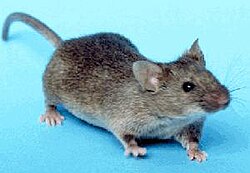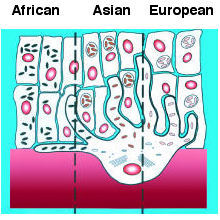Human skin pigmentation
 From Wikiversity - Reading time: 2 min
From Wikiversity - Reading time: 2 min

Welcome to the Wikiversity learning project for human skin pigmentation. Participants explore melanin, melanosomes, melanocytes, MSH and its receptors and the control of skin pigmentation.
Learning project organization
[edit | edit source]This learning project is initially organized around suggested reading and discussion. Feel free to add new reading and subsections for questions and discussion.
Melanocytes
[edit | edit source]Melanin biosynthesis
[edit | edit source]
- Characterization of a Melanosomal Transport System in Murine Melanocytes Mediating Entry of the Melanogenic Substrate Tyrosine
- A new enzymatic function in the melanogenic pathway. The 5,6-dihydroxyindole-2-carboxylic acid oxidase activity of tyrosinase-related protein-1 (TRP1)
- Polymerization of 5,6-dihydroxyindole-2-carboxylic acid to melanin by the pmel 17/silver locus protein
Melanosome biogenesis
[edit | edit source]Tanning
[edit | edit source]Melanosomes passed to keratinocytes
[edit | edit source]
Laboratory mice provide a useful experimental system for investigation of the cellular mechanisms of mammalian skin pigmentation.
Working with mice, the transcription factor Foxn1 and the growth factor FGF2 were found to be involved in the melanocyte-keratinocyte interactions that allow melanosomes to be distributed in the skin[1]. Foxn1 was originally studied because of its importance in the development of the thymus as revealed by Foxn1 mutant nude mice. Foxn1 mutations also cause failure of human hair growth[2].

- The quest for the mechanism of melanin transfer
- Tunneling nanotubes: a new route for the exchange of components between animal cells
See also
[edit | edit source]References
[edit | edit source]- ↑ "Dedicated epithelial recipient cells determine pigmentation patterns" by L. Weiner, R. Han, B. M. Scicchitano, J. Li, K. Hasegawa, M. Grossi, D. Lee and J. L Brissette in Cell (2007) Volume 130, pages 932-942.Entrez PubMed 17803914
- ↑ "Exposing the human nude phenotype" by J. Frank, C. Pignata, A.A. Panteleyev, D. M. Prowse, H. Baden, L. Weiner, L. Gaetaniello, W. Ahmad, N. Pozzi, P. B. Cserhalmi-Friedman, V. M. Aita, H. Uyttendaele, D. Gordon, J. Ott, J. L. Brissette and A. M. Christiano in Nature (1999) Volume 398, pages 473-474. Entrez PubMed 15316080
External links
[edit | edit source]- "Your Family May Once Have Been A Different Color" by Robert Krulwich. Morning Edition, February 2, 2009.
 KSF
KSF